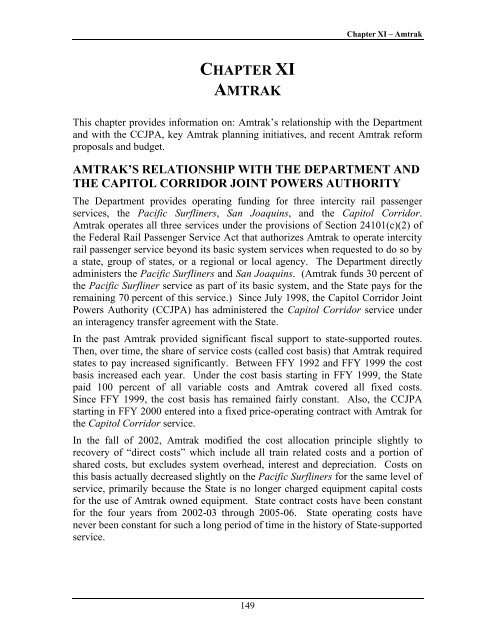California State Rail Plan 2005-06 to 2015-16
California State Rail Plan 2005-06 to 2015-16
California State Rail Plan 2005-06 to 2015-16
You also want an ePaper? Increase the reach of your titles
YUMPU automatically turns print PDFs into web optimized ePapers that Google loves.
Chapter XI – Amtrak<br />
CHAPTER XI<br />
AMTRAK<br />
This chapter provides information on: Amtrak’s relationship with the Department<br />
and with the CCJPA, key Amtrak planning initiatives, and recent Amtrak reform<br />
proposals and budget.<br />
AMTRAK’S RELATIONSHIP WITH THE DEPARTMENT AND<br />
THE CAPITOL CORRIDOR JOINT POWERS AUTHORITY<br />
The Department provides operating funding for three intercity rail passenger<br />
services, the Pacific Surfliners, San Joaquins, and the Capi<strong>to</strong>l Corridor.<br />
Amtrak operates all three services under the provisions of Section 24101(c)(2) of<br />
the Federal <strong>Rail</strong> Passenger Service Act that authorizes Amtrak <strong>to</strong> operate intercity<br />
rail passenger service beyond its basic system services when requested <strong>to</strong> do so by<br />
a state, group of states, or a regional or local agency. The Department directly<br />
administers the Pacific Surfliners and San Joaquins. (Amtrak funds 30 percent of<br />
the Pacific Surfliner service as part of its basic system, and the <strong>State</strong> pays for the<br />
remaining 70 percent of this service.) Since July 1998, the Capi<strong>to</strong>l Corridor Joint<br />
Powers Authority (CCJPA) has administered the Capi<strong>to</strong>l Corridor service under<br />
an interagency transfer agreement with the <strong>State</strong>.<br />
In the past Amtrak provided significant fiscal support <strong>to</strong> state-supported routes.<br />
Then, over time, the share of service costs (called cost basis) that Amtrak required<br />
states <strong>to</strong> pay increased significantly. Between FFY 1992 and FFY 1999 the cost<br />
basis increased each year. Under the cost basis starting in FFY 1999, the <strong>State</strong><br />
paid 100 percent of all variable costs and Amtrak covered all fixed costs.<br />
Since FFY 1999, the cost basis has remained fairly constant. Also, the CCJPA<br />
starting in FFY 2000 entered in<strong>to</strong> a fixed price-operating contract with Amtrak for<br />
the Capi<strong>to</strong>l Corridor service.<br />
In the fall of 2002, Amtrak modified the cost allocation principle slightly <strong>to</strong><br />
recovery of “direct costs” which include all train related costs and a portion of<br />
shared costs, but excludes system overhead, interest and depreciation. Costs on<br />
this basis actually decreased slightly on the Pacific Surfliners for the same level of<br />
service, primarily because the <strong>State</strong> is no longer charged equipment capital costs<br />
for the use of Amtrak owned equipment. <strong>State</strong> contract costs have been constant<br />
for the four years from 2002-03 through <strong>2005</strong>-<strong>06</strong>. <strong>State</strong> operating costs have<br />
never been constant for such a long period of time in the his<strong>to</strong>ry of <strong>State</strong>-supported<br />
service.<br />
149













